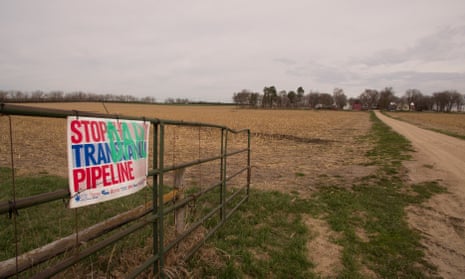A panel of Nebraska regulators have voted narrowly in favor of allowing the Keystone XL pipeline to follow a path through the state, removing the last major regulatory hurdle for the controversial project.
The Nebraska public service commission voted 3-2 to approve a permit for the pipeline, which will stretch for 1,200 miles and carry up to 830,000 barrels of oil a day. The vote saw one of the four Republicans on the commission, Mary Ridder, join with the Democrat, Crystal Rhoades, in opposing the permit. Rhoades said she was concerned about the impact upon landowners and that there was “no evidence” the pipeline would create jobs in Nebraska.
The vote will allow the pipeline to go through Nebraska, but not on the path favored by TransCanada, the developer of the project. The approved path is further east than originally planned.
The decision is likely to be immediately challenged by Native American and environmental groups that claim the pipeline endangers water supplies and will worsen climate change. Last week, an existing Keystone pipeline spilled 210,000 gallons of oil in South Dakota, although the Nebraska panel did not take this into consideration in its decision.
While the pipeline has been ostensibly approved, it faces a thicket of legal challenges that may delay or even halt the project. Bill McKibben, the co-founder of climate group 350.org and a leading opponent of the pipeline, said lawyers he’d spoken to are “cheerful and that there is “lots of room to fight.”
Michael Brune, executive director of the Sierra Club, said the group is already assessing its legal options. “Our movement defeated this pipeline once, and we will do it again,” he said.
The prospect of further courtroom battles, coupled with currently unfavorable oil prices, prompted a muted response from TransCanada to the Nebraska decision.
“As a result of today’s decision, we will conduct a careful review of the public service commission’s ruling while assessing how the decision would impact the cost and schedule of the project,” said Russ Girling, TransCanada’s president and chief executive.
Opponents in August vowed to stage mass protests against the pipeline if Nebraska regulators approved it, though say they will exhaust legal options first.
Pipeline opponents have lined parts of the proposed route with obstacles, including trees, solar panels, sacred corn from the Ponca tribe of Nebraska and a barn powered by renewable energy. Some opponents may try to physically block construction and have likened their resistance to the activists who protested against the Dakota Access pipeline in Standing Rock, North Dakota.
In March, Donald Trump reversed a decision by Barack Obama’s administration to block the pipeline extension, with the president calling the reversal a “great day for jobs and energy independence”. Trump has previously said there is “no downside” to the project.
“Nothing has changed at all in our defense of land, air and water of the Oceti Sakowin Lands,” said Faith Spotted Eagle, a member of the Yankton Sioux Nation, located in South Dakota. “If anything it has become more focused, stronger and more adamant after Standing Rock.
“It’s clear that the Trump administration, through its dirty energy policies, is intent on destroying our homelands with no regard to any group; we are all seen as dispensable, taxable and voiceless.”
TransCanada has said it is still interested in a project that has been in the works since 2008. The plan would expand the existing Keystone pipe system to transport a large volume of tar sands oil from the Canadian province of Alberta to refineries on the Gulf coast of Texas.
Environmentalists have raised concerns about the pipeline because crude oil from tar sands produces about 17% more greenhouse gases than standard crude oil. There are also fears over its impact upon the Ogallala aquifer, one of the world’s largest underground deposits of fresh water, which the pipeline will cut across.
In 2015, the state department estimated that the project would create about 42,000 direct and indirect jobs, with around 50 permanent jobs to maintain the pipeline.
